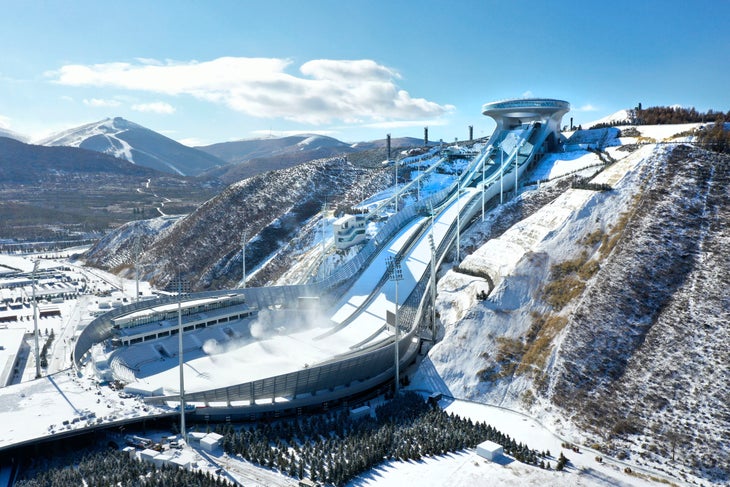Products You May Like
Blame it on a cruel mix of climate change and choosing an Olympic venue that measures snowfall in centimeters during its coldest winter months, but Olympic athletes will be competing on a mostly 100-percent artificial snow surface when the 2022 Beijing Winter Olympics kick off this weekend.
Follow the Games: SKI’s Guide to the 2022 Beijing Winter Olympics
Utilizing 100 generators and 300 snow guns, the operations team in Beijing has had to start from dirt, covering all of the surfaces at Genting Snow Park and Big Air Shougang, home to the Freestyle events, and the National Alpine Ski Centre, where the Alpine races will take place. They also have to provide coverage to the tracks and ramps at the National Biathlon Centre, National Ski Jumping Centre, and National Cross Country Centre, as well. Ironically, an uncharacteristic storm swept through the region earlier this week, dusting the slopes and ushering in unusually cold temperatures. But that’s hardly the norm.

According to a study released by researchers from the Sports Ecology Group at England’s Loughborough University and Protect our Winters, making snow for the Games will use almost 50 million gallons of chemically treated water. China counters that all of it comes from rainfall and recycled water, and that its upgraded snowmaking technology uses 20 percent less water than traditional systems.
“This is not only energy and water intensive, frequently using chemicals to slow melt, but also delivers a surface that many competitors say is unpredictable and potentially dangerous,” according to the report.
Beijing’s unique challenges affect these Olympics in various ways, including air quality, precipitation, and most acutely, temperature. Beijing is also one of the world’s most water-scarce cities.
“Most outdoor events (e.g. ski-based, snowboard-based, bobsleigh, luge, skeleton) will take place in the Yanqing and Zhangjiazou zones, with the exception of big air snowboarding and freestyle skiing, which will take place in Beijing,” the report states. “Based on historical temperature data for Beijing, nearly all days in February for the last 30 years have been above the freezing temperature for water. The Yanqing zone suffers similar problems, which will result in the use of all artificial snow.”
Further, the report states that due to climate change, Beijing will not be cold enough to host another Winter Olympics after 2050. That said, the city is in good company when it comes to Olympic hosts that might no longer be suitable places for a Winter Games going forward.
Of the 21 Winter Olympic venues since 1924, the report asserts that only 10 will have the natural snowfall and a cold enough climate to host again. Places deemed too warm for a Winter Games include Garmisch, Germany and Sochi, Russia. High-risk destinations are Chamonix and Innsbruck in the Alps, Norway’s Oslo, Calif.’s Palisades Tahoe, and Vancouver, B.C. According to the report, Olympic cities that might see another Winter Games include Cortina, Italy, Salt Lake City, and Sapporo, Japan.
As for the idea that man-made snow is inherently more dangerous for the competitors, the report shared some interesting facts about the surface and its effect on race outcomes and safety. Consisting of 30 percent ice and 70 percent air—compared to the 10 percent ice and 90 percent air composition of natural snow—man-made snow is grittier and slicker, creating a harder and faster surface. Athletes say they can always tell the difference between the two.
“If freestyle super pipes are formed from snowmaking machines in a poor snow season, the walls of the pipe are solid, vertical ice, and the floor is solid ice,” said Protect Our Winters athlete and former Olympic freestyle skier Laura Donaldson. “This is dangerous for athletes, and some have died.”
According to POW athlete and Canadian freestyle skier Phillipe Marquis, conditions are more dangerous than ever. “The amount of water required to produce substantial amounts of artificial snow to [cover] early-season venues is mind blowing,” he says. “Yes, we’ve always needed a push from artificial snowmaking, but we’ve come to an irreversible crossroads where artificial snow is now carrying a heavy load. Where will be be in five years, 10 years, 50 years?”
With fewer and fewer destinations around the globe able to host a Winter Olympics, more competitions like these Beijing games are guaranteed to be in our future. “The risk is clear: man-made warming is threatening the long-term future of winter sports.”
